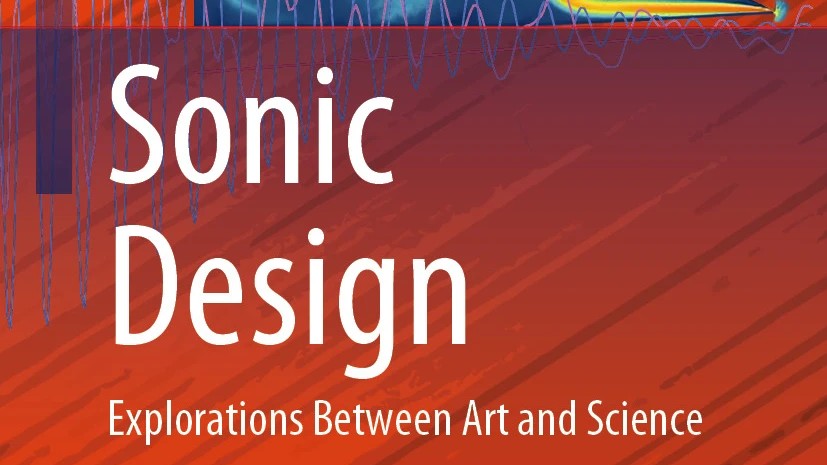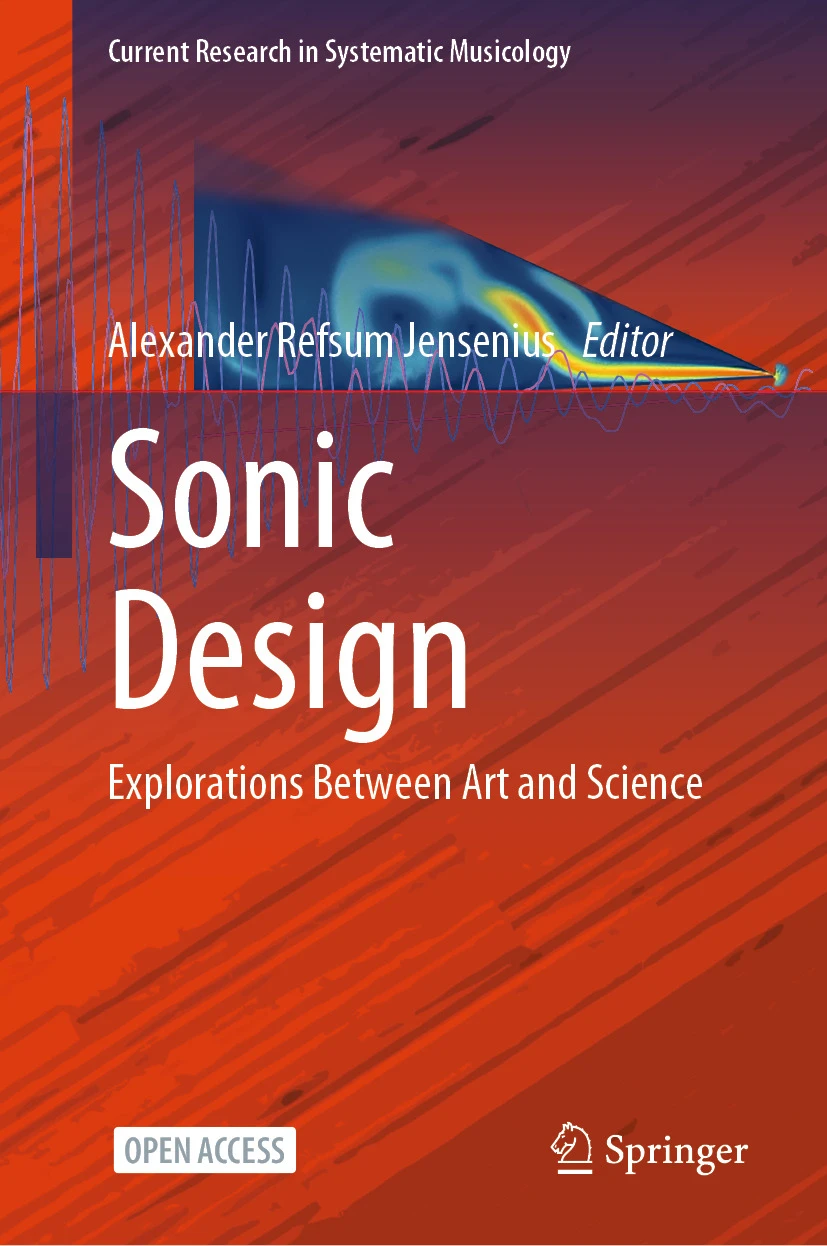I am happy to announce the publication of the anthology Sonic Design- Explorations Between Art and Science.This 17-chapter volume explores sonic design practice and theory and celebrates the lifelong achievements of Professor Rolf Inge Godøy.
The anthology is based on selected contributions at the International Seminar on Sonic Design, which took place in May 2022. The seminar was set up to celebrate Rolf Inge Godøy, my former supervisor, mentor, colleague and friend, uphon his retirement. After working closely with him for more than two decades, I wanted to bring together different perspectives I know he cares about. When I first approached him as a master’s student, I remember how he spoke about composition as “sonic design”. Thus, it became a natural term for both the seminar and the anthology (I have previously written about the difference between sound design and sonic design).
I am very happy about seeing the volume published, almost exactly two years after the seminar. I am also very greatful to the University of Oslo to provide funding so that the book is freely available to everyone. Below is the preface and table of contents.
Preface
Beeeeeeep, katchak!!! woooooOOOOooooo …. oh-Ra-ta-ta-oh-Ra-ta-ta-oh-Ra-ta-ta- oh-Ra-ta-ta-oh-Raaa … ssssssssssssssso! Try to read these words aloud. Try to per- form the words while standing. Letters on paper become sounds in the air. It is like a musical score being transformed into sound through the sound-producing actions of a musician interacting with an instrument. This is sonic design, constructing sound events and relationships between them.
In this volume, sonic design is used as a term that includes both artistic and scientific approaches to creating and studying (musical) sound. The term “sound” is typically used to describe vibrations that travel through air, while “sonic” describes anything related to sound. Thus, sound design can be thought of as designing (and producing) sounding sounds, while sonic design could also embrace designing and understanding sonic experiences.
Sonic design includes sound design practices such as recording, editing, and mixing acoustic sounds but also synthesizing entirely new sounds through analog and digital electronic devices. Over the years, these practices have merged with composition, orches- tration, and production techniques to create previously unheard-of sonic results. In addi- tion to such creative applications, sonic design also encompasses different sonification strategies aiming to create “objective” representations of data through sound. Underlying all such practical approaches to the creation of sounds for various pur- poses are several fundamental research perspectives, in music theory, music perception, embodied cognition, phenomenology, acoustics, cognitive neuroscience, and digital sig- nal processing, to mention just a few. Thus, sonic design can be seen as a meeting point between basic and applied research, “soft” and “hard” approaches, and creative and analytic perspectives.
Such a mix of art and science also summarizes the career of Professor Rolf Inge Godøy, to whom this volume is dedicated. Building on the legacy of the French com- poser Pierre Schaeffer, Godøy embraced the concept of the sounding object and how composition could be considered a combination of sounding objects in time and space. His background as a performer and composer greatly inspired his theoretical work. Throughout the 1990s, he delved into academic research to understand more about the cognitive foundations for the perception of sound as chunks and how mental imagery— musical imagery—structures how one listens to music, with or without sonic presence. This eventually led to exploring musical gestures, a concept encompassing body motion, sound, and imagery.
I was fortunate to work with Professor Godøy for nearly two decades, first as a student, then as a research fellow, and later as a colleague. I have seen him inspire several generations of students with his innovative and progressive music theoretical thinking. After a nearly 30-year-long career at the University of Oslo, he now has more time to work as a composer, using knowledge from his theoretical work in artistic practice. But his artistic activities also feed back to his scientific inquiries, most recently on the topic of sonic (co)articulation.
This edited volume is based on a selection of contributions at an international seminar organized in May 2022 to celebrate the achievements of Professor Godøy upon his retire- ment. The 17 chapters cover different approaches to sonic design practice and theory, giving readers historical backdrops and an overview of the current state of both artistic and scientific research in the field. Reflecting the breadth and width of Professor Godøy’s activities, the volume will be of interest to students, practitioners, and researchers from the arts and humanities, social and natural sciences, and design and engineering.
I am grateful to the authors for their efforts to turn their seminar presentations into original chapters and review each other’s contributions. I would also like to thank the other reviewers who helped improve the manuscripts: Andreas Bergsland, Bilge Serdar Göksülük, Björn Thor Jónsson, Bálint Laczkó, Hugh Alexander von Arnim, Joachim Mossige, Joachim Poutaraud, Kjell Andreas Oddekalv, Laura Bishop, Maham Riaz, Pedro Pablo Lucas Bravo, Qichao Lan, and Remy Martin. Finally, I thank RITMO Centre for Interdisciplinary Studies in Rhythm, Time, and Motion and the Department of Musicology at the University of Oslo for supporting the seminar and this book project and the Research Council of Norway for generous funding over the years.
BalalalalalalalalalalalaboM!
Table of contents
Part 1: Theoretical perspectives
Rolf Inge Godøy: Generic motion components for sonic design
Marc Leman: Sound design and the theory of self-augmented interactions
Mari Romarheim Haugen: Musical meter as shape: An embodied perspective on metrical trajectories and curves
Chris Stover: Prelude to a theory of gestural time, proto-geometry, and music
Sylvie Gibet: A grammar of expressive conducting gestures
Part 2: Performance perspectives
Annamaria Minafra: Different attitudes of expressive movement awareness in professional musicians
Federico Visi, Rodrigo Schramm, Kerstin Frodin, Åsa Unander-Scharin, Stefan Östersjö: Empirical analysis of gestural sonic objects combining qualitative and quantitative methods
Benjamin Lavastre, Marcelo M. Wanderley: Studying performances with digital musical instruments: A case study of Ritual, a piece for solo Karlax
Part 3: Artistic exploration
Gemma L. Crowe: Embodied sonic design: sound and the sensory apprehension of movement
Ulf A. S. Holbrook: Sonic design and spatial features
Georgios Varoutsos, John D’Arcy: The sonic imagery of the Covid-19 pandemic
Risto Holopainen: Excitations and resonances: Misinterpreted actions in Neon Meditations
Part 4: Technological innovation
Albrecht Schneider: Aspects of sound structure in historic organs of Europe
Anna-Maria Christodoulou: Exploring the electroacoustic music history through interactive sonic design
Olivier Lartillot: Musicological and technological perspectives on computational analysis of electroacoustic music
Rolf Bader, Patrick Kontopidis: Designing Musical Instruments and Room Acoustics with Acoustic Metamaterials
Cagri Erdem: Embodied perspectives in musical artificial intelligence

